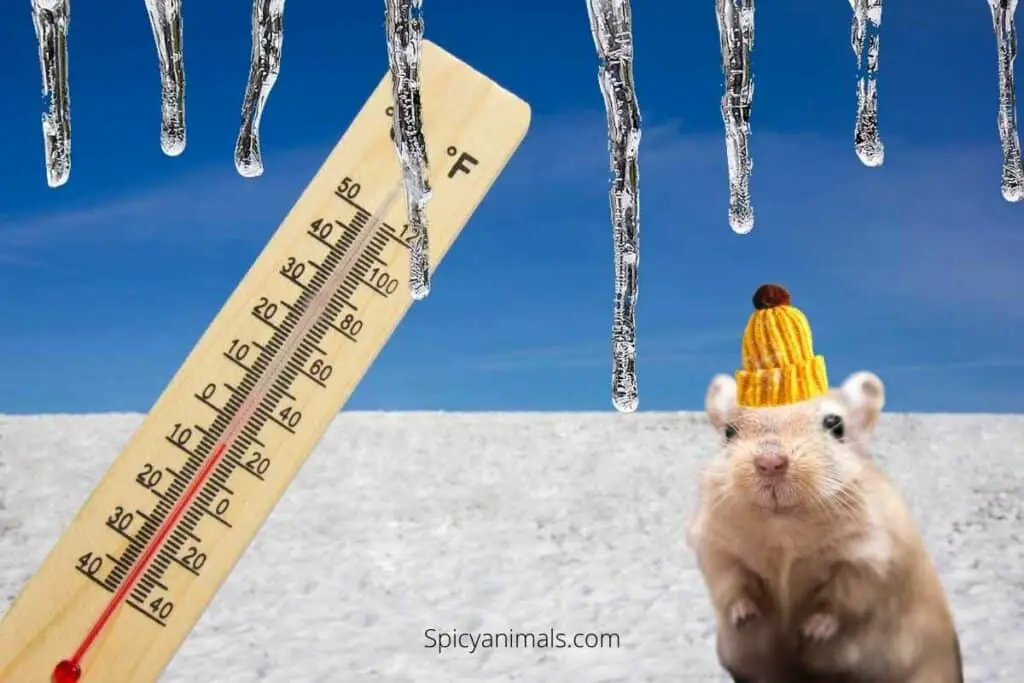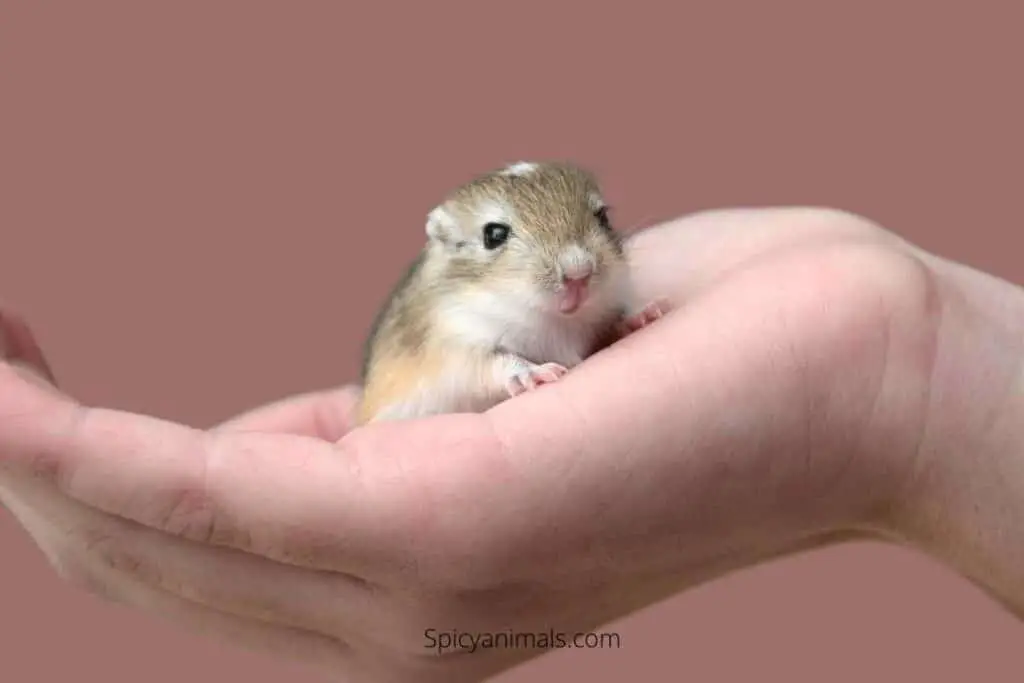When winter kicks in we head for the cold, cold winter months. You might be worried about keeping your gerbils warm when you are away to work during the day and nobody is home.
It might get pretty expensive if you let the heat run all day. In this article, we let you know how to keep your gerbil warm and some extra information that would be in handy when taking care of a gerbil during winter
Table of Contents
What Is the Ideal Temperature for Gerbils in Winter and How Can You Achieve It?
The ideal temperature range for gerbils during winter is between 65 and 75 degrees. This optimal temperature range provides gerbils with the comfort and warmth they need to thrive, while also ensuring that their sensitive respiratory systems are not overstimulated.
To achieve this temperature range, it is important to monitor the temperatures inside your gerbil’s habitat continuously and make any adjustments as necessary.
Some simple ways to keep your gerbil’s habitat at a comfortable temperature include using a high-quality heating pad or infrared heat lamp.
When the temperature in the room where the gerbils live dips below 64 degrees Fahrenheit, orienting the cage so that it receives natural sunlight for as much of the day as possible, and using room thermometers to measure the ambient air temperature during different parts of the day.
By taking these steps you can help ensure that your gerbils stay safe and healthy all winter long.

What Temperature Is Too Cold for Gerbils? Do Gerbils Get Cold Easily?
Gerbils are small, active creatures that originally come from the desert. As a result, they are well-adapted to warm temperatures and do not do well in cold weather.
In fact, gerbils can start to experience health problems when the temperature dips below 55 degrees Fahrenheit. At this temperature, their metabolism slows down and they become more prone to respiratory infections.
Their fur is not thick enough to insulate them against the cold. For these reasons, it is important to keep gerbils in a warm environment and to avoid exposing them to temperatures that are too cold. If you are wondering if gerbils hibernate I recommend reading this article.
How Warm Do Gerbils Need to Be? Can Gerbils Get Too Warm?
Gerbils are native to the deserts of Africa and Asia, so they are used to warm temperatures. However, this does not mean that they can withstand high temperatures indefinitely.
In fact, anything above 77 degrees Fahrenheit is uncomfortable for gerbils, and prolonged exposure to heat can lead to serious health problems. If you suspect that your gerbil is too warm, it is important to take immediate action.
Provide your gerbil with a cool, shady spot to rest, and offer freshwater to drink. In the wild, they have burrows where they can escape the heat, so if you have a pet gerbil it’s important to create a similar environment in their cage.
What Happens if A Gerbil Gets Cold?
When a gerbil gets cold, it will start to shiver in an attempt to generate warmth. This is because the gerbil’s body relies on an abundance of muscle activity in order to maintain its normal body temperature.
In particular, a cold gerbil will increase its heart and respiration rates, as well as its overall metabolic rate. These physiological changes allow it to warm its body through increased blood flow and accelerated heat production.
The gerbil may seek out warmer areas within its habitat in order to regain comfort as quickly as possible. Ultimately, if a gerbil becomes too cold for too long, it can suffer serious health consequences that range from lethargy and loss of appetite all the way up to organ failure.
So it is crucial that gerbils are kept at adequate temperatures at all times in order to prevent any of these negative effects from occurring.
Do Gerbils Need a Heat Lamp?
A heat mat is a common tool used to help keep pets warm and cozy. These mats are typically used in cases where the ambient temperature isn’t high enough to keep the animal comfortable.
This doesn’t necessarily mean that your gerbil needs one. Since gerbils are warm-blooded animals, they naturally produce their own heat, so they usually don’t need a heat mat unless the room they are in is too cold for you to feel comfortable as well.
It’s important to note that heat mats are designed specifically for cold-blooded animals like snakes and lizards, not warm-blooded animals like gerbils.
So if you do decide to use a heat mat for your furry friend, be sure to choose the right one for it! Otherwise, you could end up causing more harm than good.
In short, if your gerbil seems happy and healthy and is living in an appropriate environment with plenty of food and water available, chances are it doesn’t need a heat mat at all.
After all, what’s good enough for us ought to be good enough for our little friends too!
What Kind of Bedding Should Be Used in Winter to Keep Them Warm?
Gerbils are, by nature, desert dwellers. As a result, they are accustomed to living in relatively warm environments. When gerbils are kept as pets, it is important to provide them with a habitat that mimics their natural surroundings as closely as possible. Otherwise, they may become stressed or even sick.
One of the key things to remember is to keep their environment away from drafty areas. In addition, the cage should contain several inches of bedding material. This will help to keep the gerbils warm and comfortable.
You can use an old sweater, blanket, soft hay, shredded paper, or towels to line the cage. Just be sure that the fabric is clean and free of any chemicals or detergents that could harm your gerbil.
Additionally, avoid using any materials that could easily become tangled around your gerbil’s body or legs, as this could lead to serious injury.
Tips for Keeping Your Gerbils Healthy in Winter:
1. Provide your gerbils with a warm and cozy environment, a cage, or an enclosure that is shielded from drafty areas.
2. Pay close attention to the temperature in their habitat, making sure it doesn’t drop below 64/65 degrees Fahrenheit.
3. Choose bedding materials such as soft hay or shredded paper that will help insulate your gerbils and keep them warm.
4. Avoid handling your gerbils too much during the winter months, as they may be more prone to stress and illness during this time.
5. Keep an eye on their food and water intake, as a decrease in appetite or thirst may be an early sign of illness. If you notice any changes in their behavior or physical condition, consult a veterinarian for advice and treatment as needed.
Conclusion
Keeping your gerbil warm is important to their health and well-being. You can do this by making sure the room temperature stays above 65 degrees Fahrenheit and using some of the methods we’ve outlined in this post.
In addition, be sure to provide plenty of food and water for your furry friend. By following these simple tips, you can help make sure your gerbil stays healthy and happy. Have you ever had a pet gerbil? What tricks do you use to keep them warm during winter?



